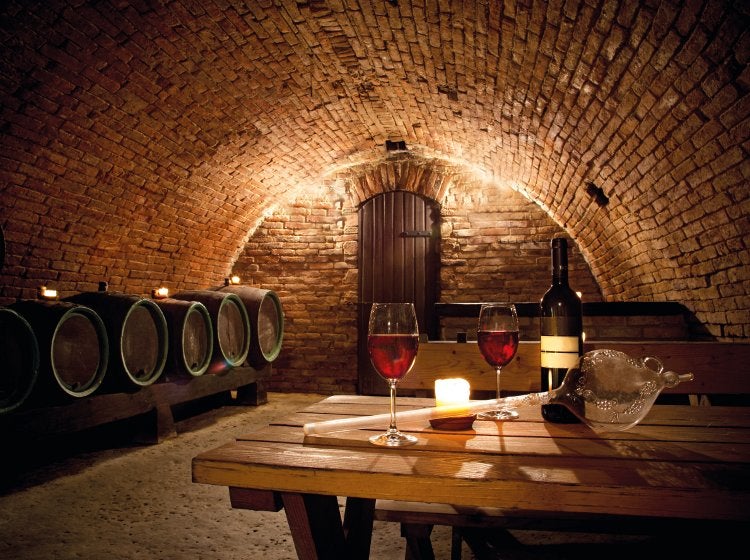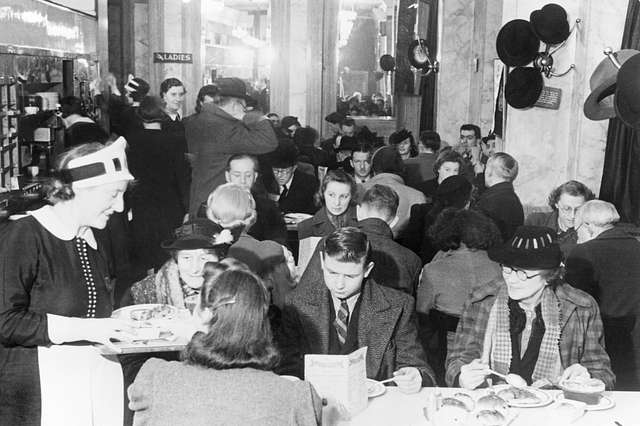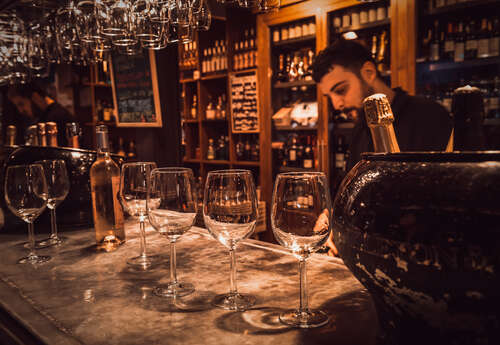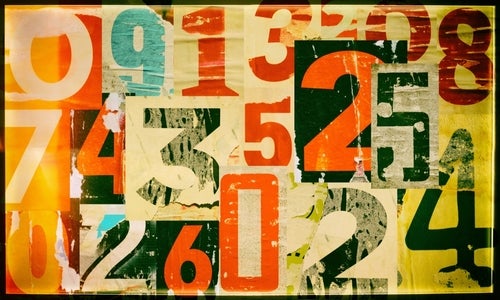
Les Papilles, which bills itself as a “bistroy parisien,” is a restaurant-cum-wine-shop-cum-épicerie. A selfdescribed cave à manger, it is auspiciously located on the rue Gay-Lussac, not far from the Jardin de Luxembourg, occupying a narrow space whose floor-toceiling wood shelves are crammed with significant wines, artisanal pâtés, cassoulets, blanquettes, sardines, fancy sea salt, and pricey olive oil. It is enormously popular.
One Saturday night in the not-too-distant past, I arranged to have dinner with friends from America. On Saturday nights, le bistroy serves a set menu, and it’s usually a very good one. The place is packed and, given its size, as noisy as the Métro at rush hour. Now, the friends in question- wine-obsessed in the nicest way possible- were on their way back to the States after having tasted their way through Burgundy and Sancerre (following my itinerary), and they wanted good food and serious wine before departing.
At Papilles there is no wine list. You inspect the shelves, select a bottle, and pay a small surcharge to drink it at table. I had sussed out Papilles’ offering online. However, as is often the case, the wines I had hoped to order were no longer available and the restaurant was too crowded- virtual scrums in the wee aisles- to permit an inspection of the shelves. But a suggestion by the owner proved irresistible: the 2012 Chave Hermitage Blanc to accompany the first course, a sweet-potato soup devilishly spiked with chunks of smoky chorizo.
In the world of food-and-wine pairings, this was undoubtedly a lovely and a very apt choice. In the context, however, it missed the mark. It was impossible to judge the wine. In an atmosphere bordering on boisterous, and with service hyperactively syncopated, I could barely taste the wine and have only the haziest recollection of its flavor or structure. About the only thing one could say is that the wine wasn’t flawed. And that brings me to my personal credo: Matching a wine to the context in which it is to be drunk is more important than matching the wine to specific foods.
The Hermitage in question needed a different context in which to be properly tasted. It needed a lower ambient decibel level. It needed space. The noise, the cheek-by-jowl seating, plus the militaristic precision of successive course deliveries at Papilles did not augur well for the appreciation of the wine. Under the circumstances, a more palatable choice would have been a more voluble, up-front white Côtes du Rhône based on Roussanne and/or Marsanne.
Alternative contexts
So, where should I have drunk that Chave Hermitage? At a small dinner party with companions like my friends at Les Papilles. Or in a restaurant where the space, the decibel level, and the pacing of service permit you to roll tongue and mind around a fine wine. This doesn’t mean solemnity. We were not about to pray over that Hermitage. (I’ll get to those wines later.) But it promised to be a serious wine, so I’d probably opt for a restaurant with some level of culinary ambition. Certainly, Michelin-starred establishments might qualify, and those aspiring to Michelin recognition also come to mind, as do gastronomically serious restaurants with thoughtful service but lacking the starched-linen amenities so beloved by Michelin inspectors- restaurants such as Le Richer and its neighbor L’Office, Le Garnier, Le Table d’Eugène, Neva Cuisine, Caillebotte, Itinératires, Le Miroir, and L’Ecailler du Bistrot. But I’ve also been able to savor wines of this quality at places as animated as Papilles, though more spacious and more leisurely- like Bistrot Paul Bert (big brother of L’Ecailler du Bistrot), where I’ve slowly relished Gevrey-Chambertins from Denis Mortet and impressed dubious Americans with the distinctive deliciousness of Leon Barral’s Jadis.
All that said, I would go back to Les Papilles. But if I wanted a good wine experience, I’d go at an off-hour. If I expected the clamor and rushed service of a Saturday fixed menu, I’d arrive early, scan the shelves, and pick out tasty serviceable wines of the order of Crozes-Hermitage, no matter the food proposed. Before moving on to additional contexts, however, let me forestall the skeptics who might seek to undercut my argument by asking me whether I’d choose a DRC, if offered, or a négociant Beaujolais while eating a hot dog at a barbecue. Of course, I’d opt for the DRC, but frankly (no pun intended, but I’ll take it), that’s only because I never get to drink DRC. I certainly wouldn’t be in a position to appreciate the glories, much less the subtleties, of the wine in that context, but neither would I pass on the opportunity to drink it.
Back to the bistrot
Moving to another context, let’s take another Hermitage but one fermented in new barriques, and aged in those barrels with regular stirring up of the lees, resulting in a style of wine I often categorize as “Too Much Winemaking.” Not only might the oak mask all other flavors, but the finished wines frequently have textures as fluffy as linen with an overdose of fabric softener. My context for such wines is the “See & Be Seen” restaurant, a trendy haven in which bold-faced names order trophy wines- eateries such as Le Coste, Pierre Gagnaire, Brasserie Thoumieux, Spring, Le Voltaire, or any of Bernard Magrez’s ventures. The wines? Beyond the very obvious mega-buck choices, including Magrez’s own stable, these might include Chapoutier single-vineyard Côte Rôties, Château La Nerthe Châteauneuf-du-Papes, and Alphonse Mellot Sancerre Generation XIX.
My next context is “Ladies Who Lunch.” The restaurants that come to mind include Mariage Frères, Ladurée, Ledoyen, Arpège, and the grand lobbies of palace hotels like the Bristol, Georges V, and the Royal Monceau. Here’s the perfect spot for well-mannered wines that are so stylish their vinification seems to have been guided by focus groups and subsequently subjected to a vinous air-brushing before being marketed. I include in this group Hugel’s Gentil, Jacky Blot’s Montlouis, the Pessac-Léognans from Smith Haut Lafitte, and the appellationless wines of the world from Ampelidae, whose widely distributed, bland biodynamic wines (yes, they exist) can be found at Cave Fauchon, both the wine shops and restaurants of Taillevent and Robuchon, as well as the wine lists of Arpège, Le Pain Quotidien, and the Royal Monceau. Now, how about the aforementioned Côtes du Rhône, as well as the prodigious wealth of similarly ranked wines from almost every region- that is, the wines most of us who aren’t one percenters drink most of the time?
It’s time to revisit the “Bistro.” Or bistrot. Or bistroy. Because it now seems that there are, if not 50, at least a dozen shades of bistrot. I think two variations on the theme, however, should suffice. The first is the classic bistro, a restaurant populaire– meaning that it’s something of a hangout for locals who come for familiar, unfussy, though often long-simmered, home-cooked food. Soul food à la française, the public equivalent to a family dinner of, say meatloaf and mashed potatoes. In other words, the contexts in which most of us non–one percenters find ourselves most of the time. And, happily, the profusion of delectable wine possibilities here is staggering- from a lip-smacking Beaujolais from Vissoux, to a toothsome Côtes du Rhône from Marcel Richaud, to the sassy, non-filtered Muscadet Amphebolite from Jo Landron.
The more upscale iterations of the bistro- Bistrot Gourmand, Bistronomie, or a goodly proportion of Le Fooding’s favorites- might include restaurants as varied as Chez Michel, L’Ebauchoir, Septime, Frenchie, and La Régalade. The wines that would be as comfortable in this context as a grape on a well-tended vine would also be mouthwatering choices for a good dinner party. And here the possibilities are again legion, starting with the premium wines from Vissoux, like his Moulin-à-Vent Rochegrès, or Richaud’s single-vineyard Cairanne l’Ebrescade, or Landron’s site-specific Fief du Breil. Add to this the many beauties from southern Burgundy- Givrys, Mercureys, Rullys- the Rhône’s villages and hyphenates, a multitude of darlings from the Loire and the Languedoc-Roussillon, and breakout stars from obscure regions like the Côtes du Marmandais’ Elain da Ros. It would take a lifetime to taste them all, but we must move on to more contexts and the wines that suit them.
Many of the bistro wines are completely at home in wine bars, no question. But why not take advantage of the by-the-glass option to sample wines you’re unsure of before committing to a bottle? This might be an obscure grape, like a Chatus from the Ardèche, or a highly-publicized natural wine, like one from Anjou’s Olivier Cousin, or simply a wine from an established grape and appellation but a producer whose wines are either unknown to you or known but not always notable.
Leo’s Bookstore and fare of the country
When tasting hundreds upon hundreds of wines, of all levels of competence and ambition, one comes across those that lack even a scintilla of luster. They’re not flawed, but they don’t have much to say for themselves. For tasters who score wines, unlike the bottles mentioned above- all of which would have scored between 13 and 18 (83–90)- these would fall below any cutoff point.
But like that old chestnut about weeds just being plants in the wrong place, these run-of-the-mill wines, if drunk in the appropriate context, can shine. When I come across such a wine I often scribble the words “Leo’s Bookstore” in my notebook. Obviously, this “context” has to be translated into lingua franca. Here’s where and how it originated. My friend Leo has a secondhand bookshop near Denfert-Rochereau in Paris. On Friday nights, a small group of us would congregate there before heading off for a very fine weekly couscous at a bar owned by Kabyles from Algeria on the Impasse de l’Astrolabe behind the Gare Montparnasse. We’d meet at Leo’s, and while he was hauling in the bookshelves, we’d stand in the back of the shop drinking a red Touraine from Jacky Preys.
Now, Jacky Preys is a charming man who owns 72ha (178 acres) of vines in the Valençay and Touraine appellations. The wines, priced at €5–8 a bottle, are no better than they need to be, given that Preys’s God-given affability conquers the hearts and minds of wine-bar owners throughout Paris when he arrives at last call and keeps each establishment open way into the wee hours. When I wrote my first Loire book, Preys’s bland, competent, low-key wines were in more than 200 Paris wine bars. I recall having scrunched up my nose in disapproval when served a Preys red on showing up for my first Friday apéritif at Leo’s. But lo and behold, the wine went down a treat- proof, if ever it were needed, of the weed theory as it applies to wine.
A weed that has a specific place in the vinosphere is one I’ve dubbed “Fare of the Country.” The wine in question usually comes from a tiny, obscure appellation- the Vendomois, for example, or the Auvergne or the Cevenne mountains. It’s a bit raw and rustic but not without a certain truth- a truth that speaks to how wine is made in a given place at a given time. It’s best drunk in its place of origin, in a local café with the plat du jour. And in such a context, it may be, for one brief shining moment, the best wine in the world. Which naturally leads me on to the best wines in the world.
PMG
“Pour Ma Gueule” translates as “for my mouth/kisser/trap” or, more loosely, “for me, myself, and I” and refers to a wine I want to keep for myself- to drink alone or with a small circle of deserving friends.
Upon reflection, I realize that this category has at least four distinct subdivisions. First comes “Adorable.” This applies to wines that don’t seek to make a grand statement. They are just so, well, adorable, you want to cuddle them. Two that come immediately to mind are Toby Bainbridge’s Grolleau rouge from Anjou, and Vincent Gaudry’s sui generis Sancerre rouges, particularly the bottling made from grapes he claims are not your everyday Pinot Noir, Pinot droit, but Pinot fin.
Then come the “Misunderestimated.” (Yes, I believe that George Bush actually coined a word.) A perfect example for me is serious Muscadet. Muscadets that I believe most consumers – even, and perhaps especially, so-called connoisseurs- don’t understand and don’t take the time to taste attentively.
Then there are the “One-offs,” or wines that are unique or unusual or hard to come by, like Ottomarzo, a red Sardinian wine made from the Pascale grape variety by biodynamic producer Dettori.
And then there’s “Moment of History”: a wine that was original and special from its birth and may require a bit of indulgence and compassion when drunk in its senescence- like, for example, a 1978 Sancerre rosé from Francis Cotat, which, along with the Dettori, I hope to serve at a déjeunerdinatoire for two wonderful wine couples later this month.
Another example is the 1996 Cour-Cheverny from François Cazin, which I served at a dinner party with two different and equally wonderful wine couples- Vincent and Catherine Ogereau and Claude and Joëlle Papin- in August 2009. I selected this bottle because it’s an unusual wine, made from the Romorantin grape – and a grape that none of the vignerons present cultivated. It also had some age on it. Winemakers who cultivate Chenin Blanc often find that Romorantin ages like that noble grape. I wanted to see how the Ogereaus and the Papins, all of them recognized Chenin artists, would react.
Romorantin is rarely, if ever, an easygoing, all-purpose white. It’s often edgy, sometimes shrill, almost always acidic, and you know when you’re drinking it. I found the wine pungent, rather oxidized, but still fresh and bracingly acidic. It was grassy, with flavors of green asparagus, verbena, citrus, and honey. Midpalate, there was a slight sensation of sweetness, as if there were 2–3 grams of residual sugar per liter. But the finish was utterly dry- or at least the high acidity persuaded me to think so. It was definitely not a wine I would serve to beginners, but I was definitely right in serving it to the vignerons in question. They all found the wine riveting; tasting, considering, then tasting again. Since I’d served the wine blind, they guessed at its origins and unanimously took it for Chenin, whereas I thought that the vegetal flavors in this particular wine made it more like Sauvignon Blanc. Full of character and very specific, it was a wine that we all loved drinking- and drinking with one another- but all agreed that it was a wine for the initiated. During dinner, and after having poured a 2004 Pouilly- Fumé HD (Haute Densité), Château de Tracy, I served the 2003 Muscadet-Sèvre et Maine Le Clos du Château l’Oiselinière. An old-vines bottling, the wine was tense and focused, with flavors of minerals and lemon zest. Pure as a rushing mountain stream, its texture was thrilling, real sur lie marrow. Now, you might have noticed that when setting forth its appellation, I didn’t mention sur lie. That’s because the wine spent longer on its lees- in this case 20 months- than the law permits. So, because it spent so much time on its lees, it couldn’t legally be considered sur lie. But that gripping thread of bubbles was there, underscoring the wine’s freshness and purity while contributing that characteristic but unique marrowy mouthfeel.
And what came to mind was Côtes des Blancs Champagne. Everyone was knocked out by the Muscadet. Claude, the Loire’s preeminent terroir maven, was convinced its elegance had to do with calcaire (limestone) in its soil makeup. But the Nantais is on the Massif Amoricain, as Claude well knows (though they were tasting this blind), and its subsoils are schist, mostly orthogneiss. The clos, despite its lack of calcaire, is very privileged. It’s on a dome overlooking the Sèvre with a full southern exposition. In fact, the Clos du Château l’Oiselinière had already been documented in the time of Napoleon. I said to Claude that the wine made me think of a Champagne from Le Mesnil. “You see,” he answered: “calcaire.” Whatever- an exquisite wine. Which leads immediately to my final category. Vin de meditation
The rarest of them all and one bound to incite the ridicule of a certain category of wine satirizers is “Wine as Art”- wine that makes you cry, wine as an out-of-body experience, wine that lifts you out of yourself; a wine that the French call a vin de méditation. As Potter Stewart memorably said about pornography (he couldn’t define it but knew it when he saw it), I’m not sure I can define this category- but I know it immediately from the first taste, even the first sniff.
One of my first such experiences was with Jean Baumard’s 1975 Savennières Clos du Papillon, which came after a long day interviewing and tasting with Baumard in September 1989. I’ll plagiarize myself here, using my description of the wine: “[It] was so glorious it brought tears to my eyes… A fine weave of fleeting aromas and flavors, a whiff of menthol, then ginger, the mellow toast of the best oak (though it never saw a barrel), quinine, cranberries, and chamomile, and a long, sapid citruszest and mineral finish. It was fully evolved yet fresh as dew. It was Balanchine, Petipa. Nothing could better express the combination of lyricism and tensile strength, the sensuality underlying sheer intellect, the ethereal floating above a solid base. Les Sylphides in a glass. It was like nothing else in the world.” So stunned was I by the wine that Florent Baumard, Jean’s son, remembers the event to this day.
The question then becomes where and when can you best appreciate such a wine. One answer came from a neighbor of Baumard’s, Pierre Leduc, the then-owner of Château Montbenault in Faye-d’Anjou, as he uncorked a ’59 Layon, saying, “You only open a wine like this if you’re going to talk about it.” Well, his wine, too, brought tears to my eyes. A velvet syrup, it was impossible to isolate all the flavors, so subtly did they melt into one sublime whole. “When the wine is this good,” Leduc said, “la langue s’en va en procession” (“the tongue does a lap of honor”).
Alone with the wine
Oddly enough, one such experience occurred at a wine tasting. Now, this wasn’t one of those moshpit tastings; it was a very civilized tasting of wines from about 30 producers of Montlouis, held in a spacious room with booths nicely distanced and large round tables set up for a buffet lunch.
I brought to the table I was sharing with a colleague two glasses of Francois Chidaine’s 2007 Montlouis Le Bournais sec Franc de Pied, a wine from ten-year-old ungrafted wines. One sniff of the wine, and my colleague and I shared amazed glances. The mere aroma of the wine made our jaws drop. Then we tasted. The wine captivated with elusive, fleeting flavors of vetiver, lime, stone, and verbena. And it seemed vast.
Its volume made me think of Gothic churches wedged into crowded ancient squares. From the outside, the structure seems small and tight; walk through the doors, and you gape at the vastness of the space that seems to balloon out to infinity, creating the impression that your palate has its own architecture and that this wine has transformed the space that is your palate into a vaulted ceiling. And you are dumbfounded.
Tasting that wine I was no longer aware of being at a public event. I was alone with the wine. From time to time, I’ve been similarly moved by a wine tasted at a restaurant. One that comes immediately to mind is a 2006 Barolo Teobaldo Cappellano Pie Franco, which I drank in the fall of 2010 at the posh Enoteca Achilli al Parlamento in Rome. Biodynamic, unfiltered, ungrafted vines planted in the 1980s, and made by the iconoclastic icon Otin Fiorin, the wine reminded me of Prieuré- Roch’s Vosne-Romanée Les Clous. The tannins were gentle; there were rich flavors of morello cherries and, most notably and most reminiscent of Les Clous, a delicate scent of rose petals, showers of them, wafting down endlessly. It was exquisite, with a tremulous fragility that brought to mind a passage from Djuna Barnes’s “Night Wood”: “as insupportable a joy as would be the vision of an eland coming down an aisle of trees, chapleted with orange blossoms and bridal veil, a hoof raised in the economy of fear, stepping in the trepidation of flesh that will become myth.”
Achilli al Parlamento had an ambitious kitchen. I recall that the food was excellent but have no memory of what we ate. But like the circumstances at the Montlouis tasting, the setting at Enoteca, with its widely spaced tables and, at least on that night, its discreet hum of background conversation were auspicious, permitting me and my equally enthralled companion to spin off into wine orbit over the Barolo. Indeed, we had no need of food.
What food, in fact, can one pair with a vin de méditation? The most persuasive pairing I’ve heard comes from Olivier Humbrecht MW, and it has everything to do with context. An empty bottle of his 2002 Pinot Gris Rangen de Thann Grand Cru Clos Saint-Urbain has sat on the windowsill of my country kitchen ever since I tasted the wine in 2005. I cannot bring myself to throw it away. What an exciting wine! Such fleeting, mingled flavors of dry honey, citrus zests, and chamomile, such exquisite texture- silky, tensile, and voluptuous all at once. And is it sweet, or is it dry? Whatever. It was a joy. It lifted me out of myself. I would take sip after sip, every sip a discovery. I don’t think I even realized that I was drinking. (And I did not get drunk.)
When I met Humbrecht several months ago, I asked him what one could possibly eat with this wine. His response was brilliant. He and his Scottish wife Margaret have a house on the northernmost tip of Scotland. Among their friends is a fisherman, and as night follows day, exchanges of wine and fresh fish take place. And are often shared. So, freshly caught prawns, grilled over an open fire, and Pinot Gris Rangen de Thann Grand Cru Clos Saint-Urbain. Yes. A thousand times, yes. I cannot imagine a more magical pairing of wine to context. Or, for that matter, to food.






